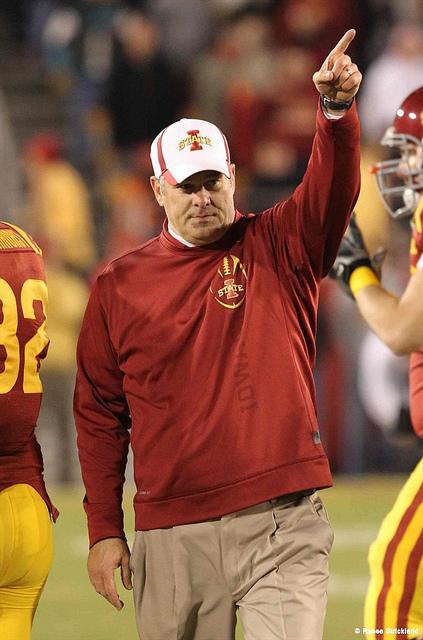by Kelly Riggs

Paul Rhoads (courtesy of CycloneFanatic.com)
This time of year is particularly tough on one select group of leaders.
Football coaches.
Paul Rhoads, the head coach of the Iowa State Cyclones, has already been dismissed with a game still left to play in the season. Despite a 7-6 record and a trip to a bowl game in his first year, his teams have averaged just four wins per season in his eight-year tenure, with a disappointing 3-9 record in 2015.
Earlier this season, Al Golden of Miami was sacked following a 58-0 loss to Clemson – despite a 4-3 record on the season.
In the NFL, it was Miami Dolphins head coach, Joe Philbin, who was dumped after only four games (read Jack Malcolm’s post about it).
Is there any doubt that leadership is tough?
It’s win or go home. With constant deadlines. Changing priorities. Difficult employees.
And leadership means you’re always up. You are always on stage. Always under scrutiny. Always subject to criticism.
Without question, the mental and emotional effort involved in leadership can be exhausting. And when things go poorly, most leaders react by doubling down. They press harder, working longer hours and pushing themselves and the team to the breaking point.
Leadership fatigue becomes a very real proposition.
You’ve probably been there as a leader – that point in time when you just need a break. A little time off to recharge and regain that edge. That’s not unusual, and typically very helpful to everyone involved.
But, there are some times when leadership fatigue actually reaches a tipping point and becomes crippling to the organization. Successive mistakes or missteps result in both a loss of credibility and confidence, and a leader is not able to regain his/her status within the organization.
The average head football coach in the NFL or NCAA logs over 100 work hours of work each and every week of the season. That’s over 14 hours per day — every single day of the week. Whether they win or lose. Whether they celebrate at the end of the year or get canned. The hours are ridiculous.
And the toll is significant. Sometimes not just physically on the coach, but on the organization as a whole.
In 2012, Andy Reid lost his job as the head football coach of the Philadelphia Eagles after 14 seasons.
He had won the NFC East title 6 times. Finished 2nd in four other seasons. He had made it to the NFC Championship game five times and advanced to the Super Bowl in 2005. The harshest critics considered him a winner and an effective coach, even if he hadn’t won on the biggest stage.
Then, in 2011, the team added several high-profile, highly paid players to a locker room already loaded with talent, prompting players and pundits alike to make Philadelphia an early-season favorite to reach the Super Bowl. Instead, injuries, an inconsistent defense, and out-of-control egos culminated in an 8-8 finish.
And a rising tide of fans calling for his ouster.
Like many leaders, Reid responded to the many challenges and adversities by simply working harder. Eagles defensive coordinator Juan Castillo made this observation:
“Nine out of 12 years going to the playoffs is not a bad thing. It’s not over yet. We’re working our [butts] off. The players are doing it. The coaches are doing it. You talk about Coach Reid — let me tell you, that man works 20, 21 hours a day. Sometimes 22 hours a day. That’s what we’re all doing now to try to get this going…”
While great leaders are often capable of tremendous effort, it is that very tendency that can lead directly to leadership fatigue.
One thing I’m certain of is that no one makes great decisions on two hours of sleep. In fact, the cumulative effect of over-work is often evident to everyone in the building except the leader doing the work, who sees only his own unwavering commitment to the task at hand.
Leadership is draining under the best of circumstances, but long-term tenure at any organization coupled with mounting adversity can lead directly to leadership fatigue. Quite often, the overwhelming stress created by setbacks leads rapidly to a further decline in performance.
Thus, the leader gets caught in an Catch-22 situation – although quite capable of leading the team, his recent failures require – almost demand – a change in leadership, because stakeholder perception has changed.
Why? Because leadership fatigue is like a disease.
Once caught by the leader, it can spread rapidly, tainting the perceptions and attitudes of key influencers and opinion-makers throughout the organization. Those individuals begin to believe that a change is needed, and once that situation reaches critical mass, the leader loses the ability to influence others. In short, his ability to lead is completely compromised.
That’s what happened in Philly. Fans demanded that Reid, a demonstrated winner and an effective leader, step aside. Not only did Reid suffer from leadership fatigue, but the fans contracted the disease.
As they often do this time of year.
——————————-
Questions:
1. Are you feeling the effects of leadership fatigue?
2. Do you need some time away without any responsibilities at work whatsoever?
3. Is that even possible? Are you so intertwined in the organization that it cannot function without you?
4. What would you do to “recharge and regain your edge?”
Kelly Riggs is a business performance coach and founder of the Business LockerRoom. A former national Salesperson of the Year and serial entrepreneur, Kelly is a recognized thought leader in the areas of sales, management leadership, and strategic planning. He serves clients ranging from small, privately held companies to Fortune 500 firms. Kelly has written two books: “1-on-1 Management™: What Every Great Manager Knows That You Don’t” and “Quit Whining and Start SELLING! A Step-by-Step Guide to a Hall of Fame Career in Sales.”